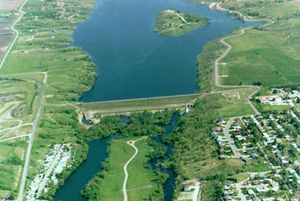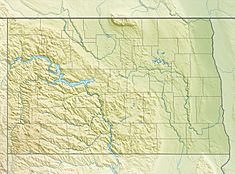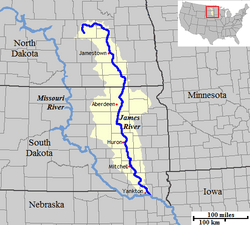Jamestown Dam facts for kids
Quick facts for kids Jamestown Dam & Reservoir |
|
|---|---|

Jamestown Dam and Reservoir
|
|
|
Location of Jamestown Dam & Reservoir in North Dakota
|
|
| Country | United States |
| Location | Stutsman County, North Dakota, United States. Located near Jamestown. |
| Coordinates | 46°56′00″N 98°42′36″W / 46.9333°N 98.710°W |
| Status | Operational |
| Construction began | 1952 |
| Opening date | 1953 |
| Construction cost | $1,941,857 |
| Owner(s) | United States Bureau of Reclamation |
| Dam and spillways | |
| Type of dam | Rolled-earth/Embankment |
| Impounds | James River |
| Height (thalweg) | 85 ft (26 m) |
| Length | 1,418 feet (432 m) |
| Width (base) | 215 ft (66 m) |
| Reservoir | |
| Creates | Jamestown Reservoir |
| Total capacity | 30,000 acre-feet (37,000,000 m3) (Normal pool); Up to 230,000 acre-feet (280,000,000 m3) (Maximum flood-storage pool) |
| Surface area | 2,095 acres (8.48 km2) (Normal pool); 13,250 acres (53.6 km2) (Maximum flood-storage pool) |
| Maximum water depth | 38 ft (12 m) |
| Website Jamestown Dam Project - U.S. Bureau of Reclamation |
|
The Jamestown Dam is a large dam built across the James River. It is located in Stutsman County, North Dakota, near the city of Jamestown. The main reason this dam was built was to control floods. It also creates the Jamestown Reservoir, a popular spot for outdoor activities.
The dam and reservoir sit on a wide, flat area made of a type of rock called shale. This shale is dark gray and looks like layers of claystone or siltstone. The valley also has many traces of alluvium, which are deposits left by water. These were mainly left during the last ice age when the area was covered by glaciers.
Contents
Building the Dam: A Big Project
Planning and Design
The idea for the Jamestown Dam came about in 1951. Engineers chose this spot because it allowed them to create a large reservoir with the smallest possible dam. They also found good materials nearby to build the dam. However, the ground underneath the dam was a bit tricky. It was not very stable and water could easily seep through it. Builders decided these issues were minor because only the lower part of the reservoir would hold water for long periods.
Several companies offered to build the dam in early 1952. A company from Sioux City, Iowa, called C.F. Lytle Company, won the contract. They started work on March 31, 1952. The special gates that control the water flow, called floodgates, were made by Hardie-Tynes Manufacturing Company in Birmingham, Alabama.
How the Dam Was Built
Construction started in April 1952. First, workers dug out the area for the dam's water gates. Then, they dug a wide trench, about 215-foot (66 m) across, for the dam's foundation. This trench helped remove any unstable soil. They also dug out the area for the spillway, which is like an emergency overflow channel.
Workers started pouring concrete in late June. By late July, they began building the main body of the dam using dirt, rock, and gravel. The upper part of the dam's front side was covered with large rocks called riprap. This protects the dam from waves. By the end of 1952, about two-thirds of the dam was finished.
Building continued quickly in 1953. The water gates were installed in April. By August 31, the gates and spillway were complete. The main part of the dam was finished by September 11. The entire dam was completed on September 20, 1953, much earlier than planned!
Dam Features and the Reservoir
The Jamestown Dam is 1,418 feet (432 m) long at its top. It stands 85 feet (26 m) tall above the James River bed. From its deepest point, it's 110 feet (34 m) high. The dam is very thick at its base, measuring 730 feet (220 m) from front to back. It's made of a huge amount of material, mostly dirt, rock, gravel, and riprap.
The dam usually lets out about 1,400 cubic feet per second (40 m3/s) of water. It has four large gates, each 5 feet by 6 feet (1.5 by 1.8 m), to control the water flow. Two gates are for normal use, and two are for emergencies. These gates can release up to 2,990 cubic feet (85 m3) of water per second. The dam also has an emergency spillway that can handle another 2,930 cubic feet (83 m3) per second. This means the dam can release a lot of water quickly if needed.
The dam's design allows for future additions, like hydroelectric generators to make electricity or a way to supply drinking water to nearby towns.
The Jamestown Reservoir usually holds about 30,000 acre-feet (37,000,000 m3) of water. Its normal surface area is about 2,095 acres (3.273 sq mi). But during big floods, it can hold much more water, up to 230,000 acre-feet (280,000,000 m3), covering an area of over 13,250 acres (20.70 sq mi).
Controlling Floods
The main job of the Jamestown Dam is to control floods. It has saved the area from about $36 million in flood damage over the years! When the dam was built, engineers found some weaknesses in its foundation. When the reservoir is at its normal level, there's little risk. But if the water level gets very high, the risk of problems increases.
In May 1969, a big flood caused the reservoir to reach its highest level ever, holding over 105,000 acre-feet (130,000,000 m3) of water. This caused some leakage from the dam. Even at this record level, the reservoir was less than half full of its maximum flood capacity. More floods in 1993 and 1995 brought the water level almost as high as in 1969.
To make sure the dam stayed safe, the Bureau of Reclamation checked it. They found that the dam could be at risk if the weaknesses were not fixed. So, in 1995, they installed eight special relief wells. These wells help drain water from the ground under the dam. In 1996, they also added a thick layer of gravel to prevent soil from washing away if water seeped through the dam. These improvements made the dam much safer.
Fun Activities at the Reservoir
Besides stopping floods, the Jamestown Reservoir is also a great place for fun! The reservoir is about 8-mile (13 km) long and covers 2,095-acre (3.273 sq mi). It's managed by the Stutsman County Park Board. People enjoy:
The lake has about 45 miles (72 km) of shoreline. It's known as an important stop for migratory birds in North Dakota. The North Dakota Game and Fish Department regularly stocks the lake with fish. You can find many types of fish here, including pike, walleye, crappie, bluegill, smallmouth bass, muskie, and bullhead.
Understanding the Ground Beneath the Dam
The Bureau of Reclamation, the agency that built the dam, has studied the ground in the reservoir area. Here's what they found:
The area around the reservoir is a gently rolling plain. It has a top layer of glacial till, which is a mix of clay, silt, sand, gravel, and boulders left by glaciers. Underneath this is a type of rock called Pierre Shale. This shale is hard, dark gray, and made of thin layers of claystone or siltstone.
The James River has cut a valley through this plain. This valley is between 1,000 and 4,000 feet wide and 50 to 100 feet deep, and it's where the reservoir now sits. The ground in the valley is made of three main types of material:
- Glacial deposits: These are mostly till, a mix of buff to light-brown clay, silt, sand, gravel, and boulders. They are usually very compact and don't let water pass through easily.
- Alluvium deposits: These are found on the valley floor. They can range from very soft clays to sands and gravel with some silt. These layers can be from a few feet thick near the valley edges to as much as 120 feet thick in the deepest part of the valley.
- Slope-wash and slump materials: These are smaller deposits found along the valley slopes. They are mostly made of materials that have eroded (worn away) from the glacial deposits.



